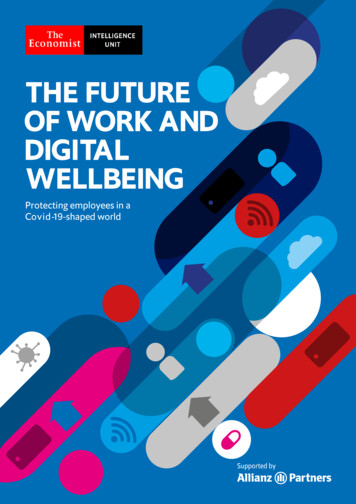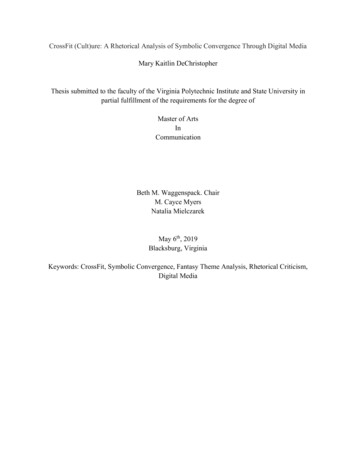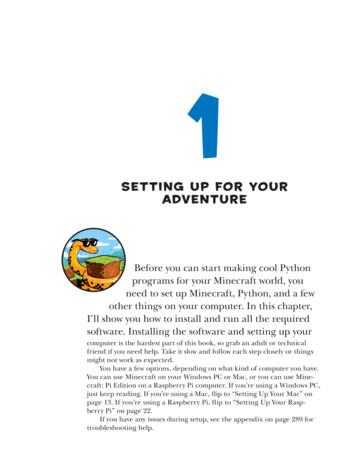
Transcription
THE FUTUREOF WORK ANDDIGITALWELLBEINGProtecting employees in aCovid-19-shaped worldSupported by
1CONTENTSExecutive summary2SECTION 1 – How is digitalisationimpacting how we work?4What will the future of work look like?‘Work from anywhere’Increased communicationGlobal teamsHow digitalisation is changingdifferent industriesMarineManufacturingFinanceOil and Gas Healthcare45678911141517SECTION 2 – Are these changes a good19 SECTION 3 – What should companies bedoing to support their employees?32Removing stigmas about accessing supportTurning policies into practiceCreating digital solutions to digital challenges333335SECTION 4 – Conclusion36SECTION 5 – Country profiles37APPENDIX – Methodology Noteon Survey62 CanadaFranceSingapore United Arab EmiratesUnited Kingdom374246525719192022222323252628292931The future of work and digital wellbeing
2EXECUTIVESUMMARYCovid-19 has accelerated existing trends towards digitalisation. This shifthas the potential to improve people’s working lives by giving them moreflexibility in where, when and how they work. However, it also threatenswellbeing through increased isolation and stress.Covid-19 has accelerated trends towardsgreater digitalisation in how we work During the pandemic, people globally had tostart working remotely, increasing their use ofdigital communications and virtual collaboration. Most sectors now face a challenge to upskilltheir workforce with the digital capabilitiesneeded to succeed as industries shift.In the Oil and Gas and Marine sectors,digitalisation presents the opportunityto address key challenges aroundsustainability, diversity and inclusion. In Finance and Healthcare, digital tools freeup employee time to offer their customersand patients a more human experience. In Manufacturing, a new focus ontechnological skills creates a new way forcompanies to engage with younger workers.Some countries are managing transitionsbetter than others: only 58% of respondentsin France working from home during Covid-19felt sufficiently supported by their employer,compared to over three quarters in the UAE.Companies need to actively manage thesedigital transitions to ensure they maximiseemployee wellbeing benefits and minimisethe risks More flexibility in where, when and how wework should be good for wellbeing. It is linked tohigher productivity, better diversity and inclusionand more active lifestyles. However, companies need to manage risksaround increased stress and isolation andexacerbating existing social inequalities.This requires business leaders and peoplemanagers to take action at every level oftheir operations Business leaders should lead by exampleto foster a culture where employees feelcomfortable to talk about their challenges andaccess the support on offer. Human resources and people managers needto make sure policies provide a foundation fromwhich teams and individuals can design theirown work-from-home systems. Employers should make sure they are up-todate on digital tools to help tackle some of thechallenges around technological transitions.They will have to adapt existing practices to workin a predominantly online environment.By putting employees’ mental and physicalwellbeing at the heart of any digital transformation,business leaders can access a range of commercialbenefits while improving staff satisfaction. In apost-Covid-19 world, or one where the virusremains part of our lives, this employee-centricapproach will be essential for helping businessesattract, retain and get the most out of theirworkforce. The Economist Intelligence Unit Limited 2020The future of work and digital wellbeing
3PREFACEThis report summarises the key findings of a research programme developedby the Economist Intelligence Unit (EIU) with support from Allianz Partners.The report is based on an extensive literaturereview and a comprehensive interview programmeconducted by the EIU between June and August2020. In total,14 experts were interviewedrepresenting academia, businesses and wellbeingspecialists. The white paper also draws from thefindings of a survey conducted by the EIU in July2020 on ‘the future of work post the Covid-19pandemic’ – speaking to respondents from Canada,France, Singapore, the United Arab Emirates andUnited Kingdom.The EIU bears sole responsibility for the contentof this report. The findings and views expresseddo not necessarily reflect the views of the partnersand experts. The report was produced by a teamof EIU researchers, writers, editors, and graphicdesigners, including:Project TeamKatherine Stewart, Project DirectorBeth Warne, Project ManagerAayushi Idda Sharma, Lead AnalystJan Copeman, Copy EditorAlan Felstead, Research Professorat Cardiff UniversityDr Aakash Ganju, Co-Founder and CEOof SaathealthDr Shelton Goode, Chief Executive Officerand President of Icarus ConsultingDr Ella Hafermalz, Assistant Professor at theKIN Center for Digital InnovationProfessor Paul de Leeuw, Director of the RobertGordon University Energy Transition InstituteSara Maude, Workplace Wellbeing SpecialistDr Almuth McDowall, Professor of OrganisationalPsychology at the University of LondonEliot Sherman, Assistant Professor ofOrganisational Behaviour at the LondonBusiness SchoolLaurel Smith-Doerr, Professor of Sociology at theUniversity of Massachusetts at AmherstMonideepa Tarafdar, Professor of InformationSystems, Lancaster UniversityAdditional Research Support from:Michael Whitmore, Research Leader atRAND EuropeJohn Bartlett, Zeina Dowidar, Lyse Mauviasand Quito TsuiAndrew Young, Financial Services Talent &Organisation Lead at AccentureGraphics and Report Design by Navig8For more information, please contact Beth Warne,Public Policy, the Economist Intelligence Unit(bethwarne@eiu.com) and Estelle Taylor, Head ofCommunications for International Health, AllianzPartners (estelle.taylor@allianz.com)ExpertsKristine Dery, Research Scientist at MITSloan School of Management in the Centre forInformation Systems ResearchAshley E. Nixon, Associate Professor of HumanResource Management and OrganizationalBehavior at Willamette University The Economist Intelligence Unit Limited 2020The future of work and digital wellbeing
4SECTION 1How is digitalisationimpacting how we work?Digitalisation – the increased use of digitaland online tools in business operations – istransforming how we work. The rise of onlineconnectivity gives people the option to workfrom anywhere, be contacted at any timeand build teams with colleagues across theworld. These three trends, which were alreadytransforming different sectors, have acceleratedsignificantly since the outbreak of Covid-19.This transition to a more digitalised way of workingirrevocably impacts people’s experience of their job– in both positive and negative ways. Employersneed to make sure there are systems in placeto maximise the benefits of digitalisation whilehelping their workforce minimise associated risks.This is particularly true during the pandemic: theincreased rate of change means many companiesneed to develop new strategies, policies and toolsto safeguard and support employee wellbeing in arapidly changing environment.In this paper, the Economist Intelligence Unit(EIU) sets out how companies can approachdigitalisation in a way that keeps employeewellbeing at the centre. First, we deep-dive intothe trends outlined above (work from anywhere,increased communications and global teams) andtheir drivers across different sectors. Secondly,we look at the benefits and risks they bring toemployee wellbeing. Finally, we lay out the nextsteps business and human resource (HR) leadersneed to consider to ensure their workforce feelssupported and remains productive as thesechanges unfold.1.1 What will the future of work look like?Over the last three decades, advances intechnology have changed the nature of work. Therise of the internet has created a new economicsystem that emphasises intangible economicassets and is less spatially bound.1 This shift hashad a knock-on effect on how we work. Increasingconnectivity has enabled three broad changes:i. Allowed people to work from outside their offices– ‘work from anywhere’ii. Increased how frequently and at what hoursa person is contactable for work purposes –‘increased communication’iii. Opened the possibility to staff a teamwith people based around the world –‘global teams’To be ready for the future of work, especially in2020, companies need to understand how theseshifts are impacting their operations and whatdrivers are accelerating these changes.1 Felstead, A. & Henseke, G. (2017). Assessing the growth of remote working and its consequencesfor effort, well-being and work-life balance. New Technology, Work and Employment, 32(3), pp. 195–212. The Economist Intelligence Unit Limited 2020The future of work and digital wellbeing
51.1.1 ‘Work from anywhere’In the last two decades, one of the most obviousways technology has changed how people work isthrough facilitating remote working. Improvementsin portable computing, remote network access andvideo conferencing have allowed people (in theory)to do substantial swathes of their jobs either fromtheir homes, while commuting or anywhere witha stable WiFi connection. Regular home workinggrew 159% between 2005 and 20182, and in early2020, 56% of employees said that at least some oftheir job could be done remotely.3This trend has clearly been accelerated by thelockdowns imposed in many countries as a resultof Covid-19. From mid-March to early-April 2020,the percentage of US workers working remotelydoubled to 62%.4 In April, the International LabourOrganisation (ILO) estimated that 2.7 billionworkers – 81% of the global workforce – weresubject to full or partial lockdown measures.5 Thissudden shift has also transformed many people’sattitudes to remote working. A recent EIU surveyfound that 75% of those who worked from homemore during the pandemic want to keep doing soto some extent after restrictions have been lifted,and 69% would want to work the majority (at leastthree days a week) from home.Importantly, this shift has also impacted howmanagers view more junior employees workingfrom home. Prior to the pandemic, junior teammembers worked from home less often than theexpert-recommended rates to optimise workerproductivity and wellbeing.6 According to AlanFelstead, Research Professor at the University ofCardiff, middle managers – rather than companyleaders – were a large driver of this imbalance. “It’sday-to-day managers who bear the risk aroundletting people work from home – and therefore,they’ve naturally been more hesitant they carry theultimate responsibility if team productivity falls.”Covid-19 has helped address this: seven-in-tenrespondents in the EIU survey are more open toemployees or junior team members working fromhome post-pandemic, and almost two-thirdswould be more comfortable with their team doingso more than three days a week.72 Telecommuting Statistics, Global workplace analytics (2019)3 Telecommuting Statistics, Global workplace analytics (2019)4 US Workers Discovering Affinity for Remote Work, Gallup (2020)5 ILO Monitor: COVID-19 and the world of work, International Labour Organisation (2020) 6Coronavirus and homeworking in the UK labour market, Office for National Statistics (2020) 7Future of Work post the COVID-19 pandemic, EIU Survey (2020) The Economist Intelligence Unit Limited 2020Technology haschanged how weworkOver80%Increasedconnectivityof employees keeptheir email open inthe background atall timesSource: Mark, G et al(2016)Pre-Covid-19,remote and homeworking around theworld has grown byWork fromanywhere159%since 2005Source: Global WorkplaceAnalytics (2019)48%Global teamsof corporate teamsinclude team membersfrom differentcountriesSource: RW3 CultureWizard(2016)The future of work and digital wellbeing
6For the privileged fewShare of US private sector workers with access toremote work before Covid-19 (%)20Top 25%% of workers1510Second 25%5Third 25%Bottom e size proportional to % of workers with access to remote work)Source: Pew Research (2019)1.1.2 Increased communicationAside from where we work and with whom wework, digitalisation is also changing how we work.Increased connectivity means employees can becontacted more frequently in a range of differentways. According to a 2016 study, on average,workers check their email around 11 times perhour, and over 80% keep their email open inthe background at all times while at work.8 Thisincreased communication trend was acceleratingprior to the pandemic, with the advent of instantmessaging (IM). In 2004, only around 10% of USworkers used IM in their offices, compared to 43%of people in 2017.9 Today, there are more userson a single provider (Slack has 12m) than thetotal number of users of any IM platform in 2004(11m).10There is a growing body of evidence to suggestthese communications help people work moreeffectively. A study looking into the time taken foremployees to complete two typical daily tasks withand without IM found that companies could savean average of 40 minutes a day per user with IM.They estimated that an organisation with 5,000people could see a rise in productivity with anestimated value of US 37.5m a year.11Technology also makes it easier for us to becontacted at all hours. In many ways, accordingto Ashley Nixon, Associate Professor of HumanResource Management and OrganisationalBehaviour at Willamette University, this enables amore natural work-life balance. “Technology hasenabled us not to have to ignore large parts of ourpersonal life while at work as well as vice versa. It8 Mark G, et al (2016, May). Email duration, batching and self-interruption: Patterns of email use on productivity and stress. In Proceedings of the 2016 CHI conference on humanfactors in computing systems (pp. 1717–1728)9 How Americans Use Instant Messaging, Pew Research (2004)10 Slack says it crossed 12 million daily active users, CNBC (2019)11 Muya Maina, T (2013) Instant messaging an effective way of communication in workplace. arXiv (2013): arXiv-1310. The Economist Intelligence Unit Limited 2020The future of work and digital wellbeing
7has minimised the disruption for people to answeran urgent question while at home, or check inwith their families while in the office depending onorganisational policies.”However, often this can spiral into work intrudingsignificantly on our home lives and disruptingwork-life balance. According to a recent studyfrom the Chartered Institute of Personnel andDevelopment, 40% of UK workers check theiremails at least five times a day on weekends oron days off, and over half mentioned strugglingto switch off from work “at least sometimes”. Thisinter-mixing of work and personal lives may alsoblur the boundaries between work and homeresponsibilities, leading to an increased sense ofstress among employees (discussed further inSection 2.2).Covid-19 is making people more comfortable withcommunication through digital tools, which is likelyto drive its increased use. For example, accordingto the EIU’s survey, seven-in-ten respondents nowfeel more comfortable doing tasks involving othersonline than prior to the lockdown. Some of thebiggest improvements were seen in conversationswith people they may be less familiar with. Forexample, 44% stated they feel more comfortabledoing onboarding of new joiners virtually andover one-third said the same about client or otherexternal meetings.7/10respondents feelmore comfortabledoing tasksinvolving othersonline than prior tothe lockdownSource: EIU Survey (2020)1.1.3 Global teamsTechnology has been one of themajor drivers of globalisation – enablingcompanies to expand all over the world. Multicountry operations have led to a rise in so-called'global-teams' – where people work togetheracross time zones and geographies– often never meeting in person.12 In the mostextreme examples, a single job is shared bymultiple people. For example, where four foreignexchange traders in investment banks in the US,London, Singapore and Sydney pass a figurativetrading position 'book' between each other on aconstant six-hour rotation.13The rise of 'global teams' is also closely linked withthe 'knowledge economy', where companiesinvest and build revenue from intangible assetssuch as Human Capital. These 'knowledgeindustries' (including tech firms, consultants etc.)have made it a necessity for top companies tohire and retain the best talent available, whereverit is in the world.14 This shift presents newrequirements for human resources professionalsto be able to find candidates from non-traditional,global sources and offer them roles and workingenvironments that motivate them to stay witha company when they may never have metcolleagues in person (see examples in Oil and Gasprofile in Section 1.2.4).12 Trends in Global Virtual Teams, Culture Wizard (2016)13 Why the Forex Market Is Open 24 Hours a Day, Investopedia (2019)14 Mockaitis, A. I., Zander, L., & De Cieri, H. (2018). The benefits of global teams for international organizations: HRimplications, The International Journal of Human Resource Management (29:14), pp 2137-2158 The Economist Intelligence Unit Limited 2020The future of work and digital wellbeing
8This trend towards creating virtual teams has beenaccelerated as a result of Covid-19, as most teams– whether previously co-located or not – are nowkeeping in touch almost completely online. Thisincreased familiarity with online methods ishelping people become more comfortable with theconcept of virtual teams, and has made many morecompanies open to working with people entirelyremotely. For example, according to the EIU’ssurvey, over two-thirds of people are now moreopen to hiring someone to join their team to workentirely remotely.15This shift is changing people’s thinking abouthow teams should be set up to get results. “Thereused to be a general belief that you should nothave more than one or two time zones acrossteams and that, where possible, they should beco-located,” said Kristine Dery, research scientistat MIT Sloan School of Management in the Centrefor Information Systems Research. “Previously, wethought people had to physically be there to getresults – but now we are seeing that when we areforced to be virtual, we can work in very differentways.” This shift might have large implicationsfor current expatriate workers, of which thereare currently almost 50 million worldwide.16 Asmore businesses are able to coordinate betweengeographies online, the demand for relocationmay decline. If these roles were done remotely,companies would be able to save on relocationand support costs and hire from a talent pool notnarrowed by a willingness to move.171.2 How digitalisation is changingdifferent industriesOperations and processes, specialist skills andsector-specific pressures drive digitalisation ineach industry. Although the trends identified above– work from anywhere, increased communicationand global teams – are present to some extentacross the economy (see table on page 9), it isimportant to also consider how sector-specificdigitalisation is impacting the ways people work.In this section, we look at five different industries:Logistics (focused on Marine), Manufacturing,Finance, Oil and Gas, and Healthcare. We examinewhat digitalisation looks like in each sector, how itis impacting the workforce and what companiesshould be doing to manage the transition.However, for the purpose of the following table, wehave looked at the broader Logistics and Transportindustry (this as opposed to looking at the Marineindustry, due to a lack of data).Previously, we thought people had tophysically be there to get results – butnow we are seeing that when we areforced to be virtual, we can work invery different waysKristine Dery, research scientist at MIT Sloan School ofManagement in the Centre for Information Systems Research15 Future of Work post the COVID-19 pandemic, EIU Survey (2020)16 Glob
remote and home working around the 1.1.1 ‘Work from anywhere’ In the last two decades, one of the most obvious ways technology has changed how people work is through facilitating remote working. Improvements in portable computing, remote network access











